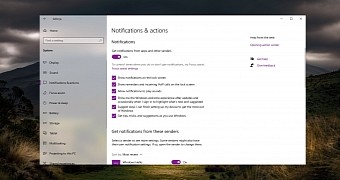As you probably noticed if you’re a long-time Windows 10 users, every time you install a new feature update for the operating system, you end up with a welcome screen when you log in to the desktop once again.
This welcome screen actually has a very simple purpose: it typically helps beginners figure out how to use the operating system, and at the same time, it shows a summary of the improvements included in the latest feature update.
Of course, such a welcome screen comes in handy especially to rookies, but on the other hand, it’s something that power users would gladly disable for a more straightforward approach when logging in to the desktop after a Windows 10 feature update.
At first glance, disabling the Windows 10 welcome experience isn’t necessarily a difficult thing to do, but Microsoft has actually included a dedicated toggle in the Settings app, and there’s a chance many people don’t even find it.
As a side note, one of Microsoft’s priorities in Windows 10 is discontinuing the classic Control Panel and moving all options to the Settings app. This is because the Settings app provides a more modern experience that aligns with the approach Microsoft is using for Windows 10, while the classic Control Panel is part of the traditional push that was part of Windows 7.
Of course, Microsoft ditching the Control Panel has several drawbacks, and one of them is Windows 7 users upgrading to Windows 10 feeling lost when it comes to setting up the operating system. And then, it’s the Settings app itself becoming more cluttered, though you should always rely on the search feature to find something that you want to modify in Windows 10.
Leaving aside these shortcomings, the Settings app is now Microsoft’s only focus when it comes to configuring Windows 10, and it’s also the home of an option for the welcome experience we discussed above.
And it all comes to just a simple toggle that you’ll find at the following location:
Windows 10 > Settings app > System > Notifications & actions
The option that you’re looking for is called:
Show me the Windows welcome experience after updates and occasionally when I sign in to highlight what’s new and suggested
The method described above also applies to Windows 10 November 2020 Update, the most recent feature update for the operating system that’s now going live gradually to devices across the world.
And of course, there’s a very good chance it’ll work in the next Windows 10 feature update coming in 2021 – just like this year, Microsoft plans to roll out two feature updates next year, one in the spring and another one in the fall.
Windows 10 version 21H1 will be another small update focused on under the hood improvements and less on new features, pretty much just like the November 2020 Update does right now. On the other hand, the fall update expected to go live in October or November 2021 is expected to bring many more improvements, including new capabilities.
Earlier this week, it has emerged that Microsoft might be planning to bring Android apps to Windows 10 without the need for the Your Phone app, and this fall update is likely to be the one introducing this functionality. Needless to say, if this is the case, we should expect the feature to go live first in Windows Insider builds going live in the first half of 2021.
At this point, Microsoft has remained completely tight-lipped on this topic.

 14 DAY TRIAL //
14 DAY TRIAL //